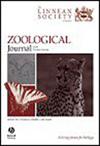A new specimen of the early branching crocodyliform Platyognathus hsui extends the record of gobiosuchids back 67 million years
IF 2.8
2区 生物学
Q1 ZOOLOGY
引用次数: 0
Abstract
Crocodyliforms are poorly known from the Early Jurassic Lufeng Formation of China, and a new specimen of Platyognathus hsui is by far the most complete specimen yet known. It shares with the missing holotype and the neotype the very unusual features of a dentary caniniform that is polygonal in cross-section and the complete fusion of the dentary symphysis, and the new specimen provides four additional features diagnosing the species. Features such as a relatively broad rostrum and a posteroventrolateral process on the squamosal place it with taxa closer to extant crocodylians than are Orthosuchus and Protosuchus, as an early branching relative of the Gobiosuchidae. The oldest previous record of the gobiosuchid lineage was from the late Barremian stage of the Early Cretaceous, and this extends the fossil record of the lineage back by 67 Myr. We recognize a new superfamily, Gobiosuchoidea, to include Platyognathus hsui and gobiosuchids.一个新发现的早期分支鳄鱼形的hsui platyonathus标本,将类人猿的记录延长到了6700万年前
中国早侏罗世陆峰组的鳄鱼形动物鲜为人知,而一种新的hsui Platyognathus标本是迄今为止已知的最完整的标本。它与缺失的全型和新型犬科动物具有非常不寻常的特征,即横截面呈多边形,并完全融合了齿状联合,并且新标本提供了诊断该物种的四个额外特征。相对较宽的喙部和鳞片上的后腹侧突等特征使其分类群比正鳄和原鳄更接近于现存的鳄鱼类,是虾鳄科的一个早期分支亲戚。此前最古老的此类虾蛄谱系记录来自早白垩纪巴雷米亚晚期,这将该谱系的化石记录延长了67亿年前。我们发现了一个新的超科Gobiosuchoidea,包括Platyognathus hsui和gobiosuchids。
本文章由计算机程序翻译,如有差异,请以英文原文为准。
求助全文
约1分钟内获得全文
求助全文
来源期刊
CiteScore
6.50
自引率
10.70%
发文量
116
审稿时长
6-12 weeks
期刊介绍:
The Zoological Journal of the Linnean Society publishes papers on systematic and evolutionary zoology and comparative, functional and other studies where relevant to these areas. Studies of extinct as well as living animals are included. Reviews are also published; these may be invited by the Editorial Board, but uninvited reviews may also be considered. The Zoological Journal also has a wide circulation amongst zoologists and although narrowly specialized papers are not excluded, potential authors should bear that readership in mind.

 求助内容:
求助内容: 应助结果提醒方式:
应助结果提醒方式:


